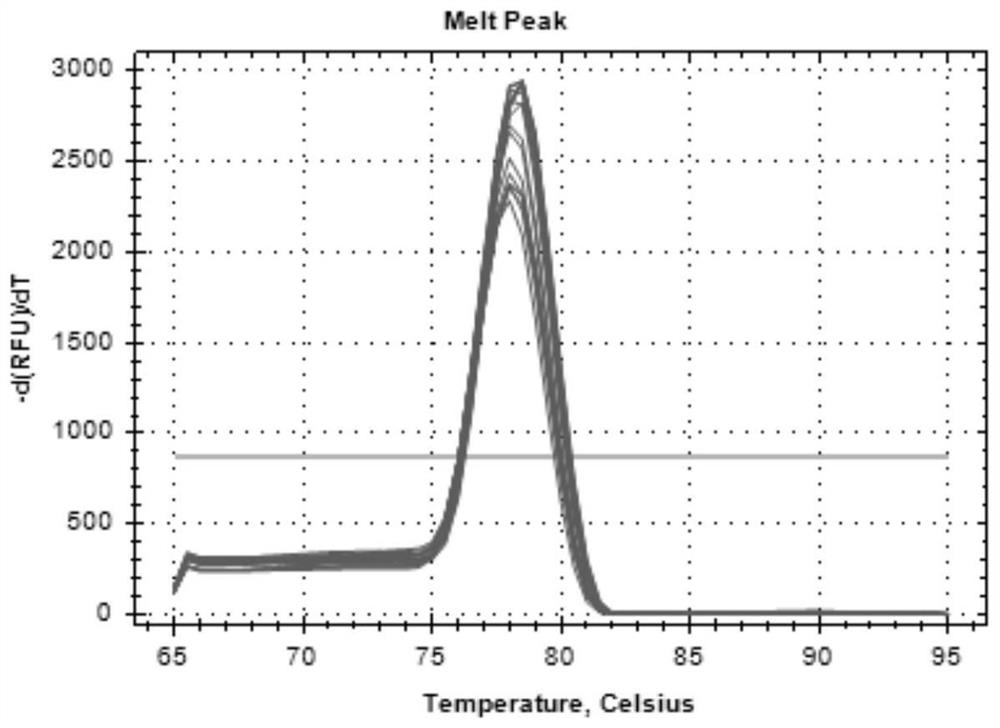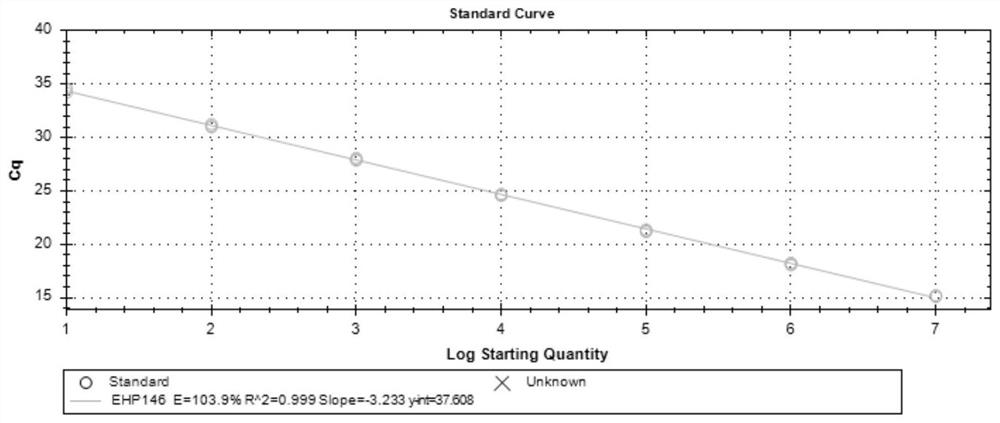Primer and method for fluorescent quantitative PCR detection of Enterocytozoon hepatopenaei (EHP)
A fluorescence quantitative, Enterospora hepatis technology, applied in biochemical equipment and methods, microbial determination/inspection, DNA/RNA fragments, etc., can solve the problems of time-consuming, cumbersome operation, etc. The effect of shortening the detection time
- Summary
- Abstract
- Description
- Claims
- Application Information
AI Technical Summary
Problems solved by technology
Method used
Image
Examples
Embodiment example 1
[0035] The pMD19T cloning vector involved in this implementation case, DH5α cloning competence and easydilution for constructing standards for diluted plasmids were purchased from Takara Biotechnology Co., Ltd.
[0036] The EHPSWP sequence information involved in this implementation case has been published in NCBI.
[0037] This implementation case constructs the EHP-SWP standard plasmid, the main steps are as follows:
[0038] 1) Extract the total DNA of the hepatopancreas of Penaeus vannamei naturally infected with EHP;
[0039] 2) Design primers according to the EHP-SWP sequence published by Ncbi, and obtain the EHP-SWPORF sequence by PCR amplification;
[0040] 3) connect the pMD 19T plasmid, and transform DH5α;
[0041] 4) Positive clones were obtained through sequencing identification, and after expansion and cultivation, plasmids were extracted;
[0042] 5) The Nanodrop nucleic acid analyzer measures the plasmid concentration, and converts the EHP infection copy numb...
Embodiment example 2
[0045] Screening of implementation case 2 specific primers
[0046] On the basis of the preliminary screening, the following 2 pairs of primers were finally determined for multiple comparison experiments:
[0047] Primer pair 1EHP146F: TGGCGGCACAATTCTCAA
[0048] EHP146R: GCTGTTTGTCTCCAACTGTA
[0049] Primer pair 2F: TGGCGGCACAATTCTCAAACAT
[0050] R: GCTGTGTCTGTGTAAATATCGTCTC
[0051] In this implementation case, TB Green Premix Ex Taq II (TliRNaseH Plus) (2*) was purchased from Takara Biotechnology Co., Ltd.
[0052] In this implementation case, by constructing a standard curve, the amount of EHP infection in Penaeus vannamei juveniles (<2cm) and "growth retarded" adult Penaeus vannamei was detected. The specific steps are as follows:
[0053] 1. Sample collection and DNA extraction: take whole individuals from larvae, larvae and juveniles smaller than 2cm, and hepatopancreas from juveniles larger than 2cm, subadult shrimp and adults. Samples were collected in the range...
Embodiment example 3
[0063] In this implementation case, TB Green Premix Ex Taq II (TliRNaseH Plus) (2*) was purchased from Takara Biotechnology Co., Ltd.
[0064] In this implementation case, by constructing a standard curve, the amount of EHP infection in Penaeus vannamei juveniles (<2cm) and "growth retarded" adult Penaeus vannamei was detected. The specific steps are as follows:
[0065] 1. Sample collection and DNA extraction: take whole individuals from larvae, larvae and juveniles smaller than 2cm, and hepatopancreas from juveniles larger than 2cm, subadult shrimp and adults. Samples were collected in the range of 10-50 mg, and the total DNA of the samples was extracted using the Qiagen DNA Mini Kit kit in strict accordance with the kit instructions.
[0066] 2. Fluorescent quantitative PCR detection:
[0067] 1) The reaction system is as follows, with a total volume of 25ul: TB Green Premix Ex Taq II (TliRNaseH Plus) (2X): 12.5ul, 1.25ul each of the primers of the sequences described in E...
PUM
 Login to View More
Login to View More Abstract
Description
Claims
Application Information
 Login to View More
Login to View More - R&D Engineer
- R&D Manager
- IP Professional
- Industry Leading Data Capabilities
- Powerful AI technology
- Patent DNA Extraction
Browse by: Latest US Patents, China's latest patents, Technical Efficacy Thesaurus, Application Domain, Technology Topic, Popular Technical Reports.
© 2024 PatSnap. All rights reserved.Legal|Privacy policy|Modern Slavery Act Transparency Statement|Sitemap|About US| Contact US: help@patsnap.com










